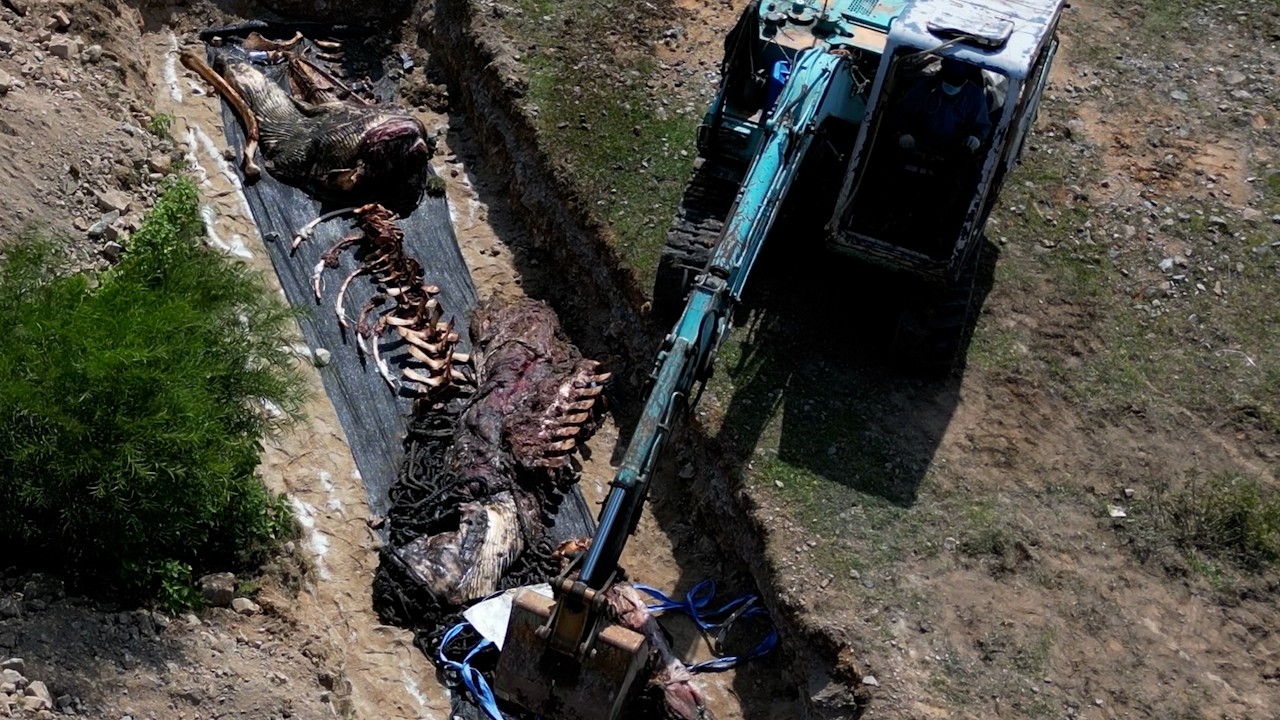
Hong Kong buries dead whale earlier spotted alive in city’s waters, carcass treated with chemicals before process
- Bryde’s whale had been talk of the town for many whale-watchers who used chartered vessels in July to view it, but animal later found dead
- Burial site at High Island Reservoir thought to be same location where a beached sperm whale was buried in 2003
The male juvenile Bryde’s whale, measuring more than eight metres (26 feet), sparked a whale-watching frenzy with chartered vessels in mid-July.
It was found dead off Shelter Island in Sai Kung on July 31 and its body then transported to a restricted location in High Island Reservoir’s west dam.

By Tuesday 2pm, on-site personnel from the Agriculture, Fisheries and Conservation Department, City University, Ocean Park and outsourced contractors had readied a pit for the burial using an excavator.
The burial lasted about an hour after workers scattered deodorant powder and laid black cloth lining at the base of the pit.
The whale’s skull was first to be placed in the pit using an excavator, with workers sequentially placing the vertebrae, ribs and other bones in anatomical order.
The last piece of its body was placed in the pit at around 3pm, and it was also covered with a black cloth to prevent feral dogs from scavenging.
Analysis of samples of tissue from the whale were still under way, authorities said on Sunday.
The Post learned that the burial was not fully completed, with work to continue on Wednesday. The nature of the remaining work is unclear.
The burial was initially set for Monday, but was delayed due to a lack of resources. About 60 sandbags and cranes were delivered to the site on Monday afternoon.
At around 10am on Tuesday, staff in protective clothing started skimming off parts that appeared to be the remaining flesh on the whale’s carcass.

The whale’s baleen, or specialised teeth for filter feeding, had apparently been removed, as well as most of the meaty parts of its body, leaving behind mostly bones.
The personnel also separated the animal’s spine into individual sections for burial.
One worker said: “The smell was horrendous, especially when the whale was flipped over revealing the remaining fatty tissue underneath. The fat spilled everywhere.”
The worker, who asked not to be named, said he usually worked on government renovation projects and it was his first time handling a whale carcass.
“The situation was particularly unbearable when there was no wind and the air stood still. My mask didn’t offer any protection,” he said.
“I’m impressed by the veterinary team. I was told one of the foreign experts even cut open the whale’s belly without putting a mask on.”
The whale’s bones will be retrieved from the pit after the remaining soft tissue decomposes. Authorities said the skeleton would be donated to Ocean Park for research purposes.
Decomposition is expected to take more than six months.
The carcass was treated with chemicals before the burial, and experts said the process was safe and often used to ensure clean bones for research and display.
Taison Chang Kai-tai, the chairman of the Hong Kong Dolphin Conservation Society, suggested authorities should cordon off the area to prevent the public from being affected.
The same site is believed to have been used to bury a 10-metre sperm whale in July 2003 after it was found beached in Big Wave Bay.
The animal was put down after several attempts at rescue failed.

